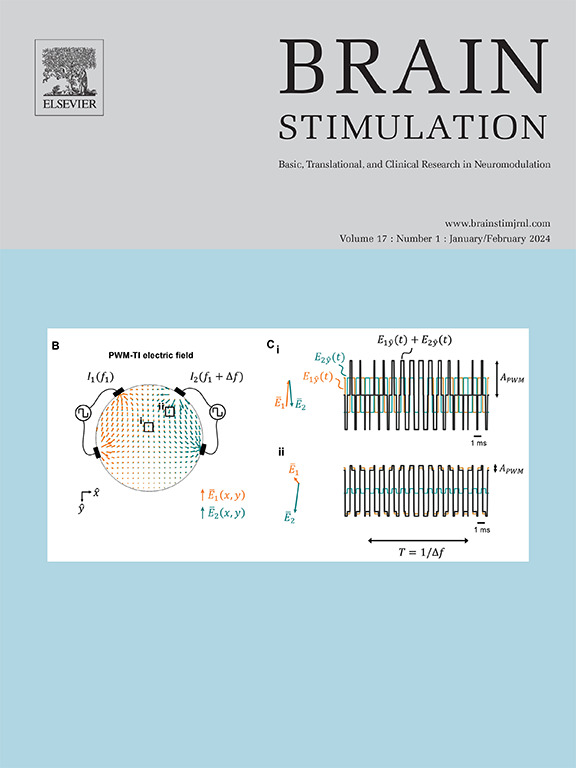Controlling the local extracellular electric field can suppress the generation and propagation of seizures and spikes in the hippocampus
IF 7.6
1区 医学
Q1 CLINICAL NEUROLOGY
引用次数: 0
Abstract
Objective
Neural activity such as theta waves, epileptic spikes and seizures can cross a physical transection using electric fields thus propagating by ephaptic coupling and independently of synaptic transmission. Recruitment of neurons in epilepsy occurs in part due to electric field coupling in addition to synaptic mechanisms. Hence, controlling the local electric field could suppress or cancel the generation of these epileptic events.
Methods
4-aminopyridine (4-AP) was used to induce spontaneous epileptic spikes and seizures in longitudinal hippocampal slices in-vitro. Two extracellular recording electrodes were placed in the tissue, one at the edge of the slice on the temporal side at the focus of the epileptic activity and the other on the septal side to record the propagation. Two stimulating electrodes were placed outside the slice at the edge of the focal zone. An extracellular voltage clamp circuit maintained the voltage within the focus at 0V with respect to the bath ground.
Results
Experiments showed that 100 % of the epileptic activity originated at the temporal region and propagated to the septal region of the slices thereby establishing the existence of a focus in the temporal end of the tissue. The clamp achieved 100 % suppression of all seizure activity in the tissue with current amplitudes between 70 and 250 nA. No spikes or seizures were observed in either the focus or the septal region when the clamp was “on”. When the clamp was turned off, both the spikes and seizure events recovered immediately.
Conclusions
The experiments show that controlling the extracellular voltage within a focus can prevent the generation and the propagation of epileptiform activity from the focus with very low amplitudes currents.
控制局部细胞外电场可以抑制海马中癫痫发作和尖峰的产生和传播。
目的:神经活动如θ波、癫痫峰和癫痫发作可以通过电场跨越物理横断面,从而通过触觉耦合传播,独立于突触传递。除了突触机制外,癫痫中神经元的募集部分是由于电场耦合引起的。因此,控制局部电场可以抑制或取消这些癫痫事件的产生。方法:用4-氨基吡啶(4-AP)诱导离体海马纵切片自发性癫痫峰和癫痫发作。在组织中放置两个细胞外记录电极,一个在颞侧癫痫活动焦点的切片边缘,另一个在间隔侧记录繁殖。两个刺激电极被放置在聚焦区域边缘的切片外。细胞外电压箝位电路使焦点内的电压相对于槽地保持在0伏。结果:实验表明,100%的癫痫活动起源于颞区,并传播到切片的间隔区,从而建立了组织颞端存在焦点。钳钳在70 - 250nA的电流范围内实现了对组织中所有癫痫活动的100%抑制。当钳钳“打开”时,在病灶或隔区均未观察到尖峰或癫痫发作。当钳子关闭时,尖峰和癫痫发作都立即恢复。结论:实验表明,控制病灶内的细胞外电压可以防止极低振幅电流的病灶产生和传播癫痫样活动。
本文章由计算机程序翻译,如有差异,请以英文原文为准。
求助全文
约1分钟内获得全文
求助全文
来源期刊

Brain Stimulation
医学-临床神经学
CiteScore
13.10
自引率
9.10%
发文量
256
审稿时长
72 days
期刊介绍:
Brain Stimulation publishes on the entire field of brain stimulation, including noninvasive and invasive techniques and technologies that alter brain function through the use of electrical, magnetic, radiowave, or focally targeted pharmacologic stimulation.
Brain Stimulation aims to be the premier journal for publication of original research in the field of neuromodulation. The journal includes: a) Original articles; b) Short Communications; c) Invited and original reviews; d) Technology and methodological perspectives (reviews of new devices, description of new methods, etc.); and e) Letters to the Editor. Special issues of the journal will be considered based on scientific merit.
 求助内容:
求助内容: 应助结果提醒方式:
应助结果提醒方式:


